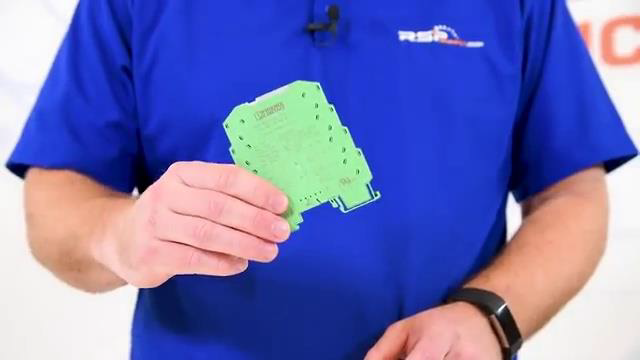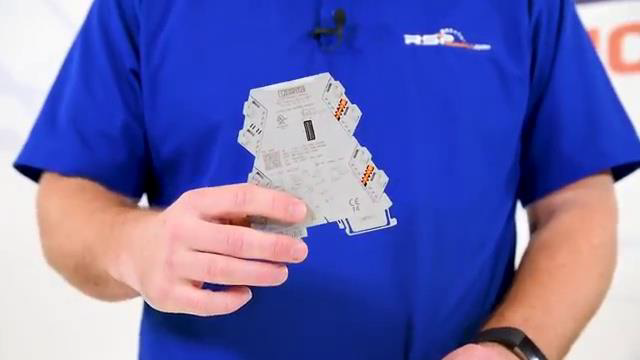Signal_Conditioning_Isolaters_Converters_Amplifiers_and_Splitters.pdf
Signal conditioning devices can be used in situations where the signal will encounter issues as it is transmitted back to the controller or PLC to assist in avoiding some of the complications that can arise.
Signal Isolators
- Protect sensitive equipment
- Separates the signal generating device from the controller, thus protecting it
- Filter any noise that might arise from any disturbances along the signal path back to the PLC
- Filter electrostatic interference that can be caused from ground loops which can detract from the accuracy levels of the signal you are trying to detect
Signal Converter
- Takes one type of signal, and changes it to something else
- In some cases, the signal converter has the ability to read multiple signals types and can be configured to send multiple output signals types, giving you several options with only one device. Conversely, there are signal converters that only have the ability to read one input signal type… and convert that to only one output signal type.
Signal Amplifiers
- Increases the resolution of the input signal
- Increases the signal to noise ratio
Signal Splitters
- Does not technically fall in the same category as the other types of conditioners
- A signal splitter does not change the signal, it simply allows you to send the signal to more than one location
Transcript:
[0m:4s] Hi this is Josh Bloom, welcome to another video in the RSP Supply education series. If you like these videos, it certainly helps us out if you can please like and subscribe.
[0m:13s] In today's video, we are going to be discussing signal conditioning for industrial control signals.
[0m:19s] In some of our other videos, we have discussed several different types of control signals in more detail. For more information on those signal types, please click on the link in the description below. In many cases, you can simply receive data from the sensors or transmitters you have in the field. However, there are situations where the signal will encounter issues as it is transmitted back to the controller or PLC.
[0m:41s] Signal conditioning devices can be used in these situations to assist in avoiding for some of the complications that can arise.
[0m:49s] Today we will discuss the most common types of signal conditioning devices and what they are specifically used for.
[0m:56s] These include signal isolators, signal amplifiers, signal converters, and signal splitters. We will briefly discuss the purpose of each and applications you might want to use them in.
[1m:8s] There are other categories of signal conditioners which we will not discuss in today's video.
[1m:13s] First, let's talk about signal isolators. Signal isolators are used for many different reasons and are one of the most common types of signal conditioning devices.

[1m:22s] One of the main reasons you use the signal isolator is to protect sensitive equipment, such as a PLC from potential hazards that may originate at the device that is connected to such as a sensor or transmitter.
[1m:36s] The isolator separates the signal generating device from the controller, thus protecting it.
[1m:42s] Isolators can also be used to filter out any noise that might arise from disturbances along the signal path back to the PLC.
[1m:50s] They can also filter electrostatic interference that can be caused from ground loops which can detract from the accuracy levels of the signal you're trying to detect.
[2m:0s] These ground loops can also potentially cause damage to any of the devices they interact with.
[2m:5s] It is common to see signal isolators in both a two wire and four wire configuration.
[2m:11s] With a four wire setup, it is necessary to provide separate power to the isolator. Conversely when using a two wire set up, you have the ability to supply loop power.
[2m:21s] Another type of signal conditioning device is a signal converter. Like, its name would suggest, a signal converter would take one type of signal and change it to something else.

[2m:31s] So, why would you need to change the type of signal in the first place? Let me give you an example. Let's assume you have a sensor in the field measuring temperature and that sensor you are using is an RTD or resistance temperature detector.
[2m:44s] Also, in this scenario, let's say that the PLC you're using does not have the ability to read RTD signals. In this case, you need something that can interpret the RTD signal and convert it to something that the PLC can understand, possibly 4 to 20 milliamp signal.
[3m:1s] In this case, a signal converter would be used to perform the signal conversion.
[3m:5s] There are several different types of signal converters with varying degrees of functionality. In some cases, the signal converter has the ability to read multiple signals and can be configured to send multiple output signal types,
[3m:18s] giving you several options with only one device. Conversely there are signal converters that have the ability to only read one input signal type and convert that to only one output signal type. So, it is important to select the correct converter that will best fit your needs.
[3m:35s] Next, let's talk about signal amplifiers. A signal amplifier has two main functions that it can perform. The first is to increase the resolution of the input signal. This will allow for more accurate and detailed data to be sent to the controller which enable you to better monitor and control these devices.
[3m:54s] Another important function that amplifiers perform is increasing the signal to noise ratio. This will enable you to more easily to receive the necessary data from your sensors or transmitters with reduced disturbances in your signal.
[4m:9s] This can provide a much more consistent and reliable performance from the device. Lastly, let's talk about signal splitters. A signal splitter does not technically fall into the same categories other types of conditioners.
[4m:22s] The other devices that we have already discussed will alter or change the signal in some way. However, a signal splitter does not change the signal, it simply allows you to send the signal to more than one location.
[4m:34s] For example, if you have a signal that needs to be monitored by a local PLC as well as another PLC in a remote location, the signal splitter can be used to send the data to both PLCs without any signal degradation.
[4m:48s] As you can see, there are several options available when a signal needs to be altered or changed. Each device discussed today can be purchased as an isolated device that will perform only one function. However, in many cases you can purchase a device that will allow for multiple functions to occur at one time. Such as a signal converter and an isolator combined.
[5m:9s] It is important to know the requirements of your specific scenario and select the right kind of signal conditioner for that job.
[5m:17s] For a full line of signal conditioning, devices such as isolators, amplifiers, converters, and splitters, and thousands of other products, please go over a website. For more information or other educational videos, go to RSPSupply.com, the Internet's top source for industrial hardware. Also, don't forget: like and subscribe.




